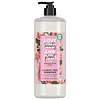What's inside
What's inside
 Key Ingredients
Key Ingredients

No key ingredients
 Benefits
Benefits

 Concerns
Concerns

 Ingredients Side-by-side
Ingredients Side-by-side

Water
Skin ConditioningCyclopentasiloxane
EmollientPropylene Glycol
HumectantTriethanolamine
BufferingNiacinamide
SmoothingRicinus Communis Seed Oil
MaskingHydroxypropyl Guar
Emulsion StabilisingHydrolyzed Wheat Protein
Skin ConditioningHydroxycitronellal
PerfumingHydrolyzed Corn Protein
Skin ConditioningHydrolyzed Soy Protein
HumectantHydroxypropyltrimonium Hydrolyzed Wheat Protein
Skin ConditioningPhenoxyethanol
PreservativePEG/PPG-17/18 Dimethicone
EmulsifyingBehentrimonium Chloride
PreservativeTrideceth-6
EmulsifyingPolyquaternium-4
Dimethiconol
EmollientLimonene
PerfumingPanthenol
Skin ConditioningBenzyl Salicylate
PerfumingLinalool
PerfumingBenzyl Alcohol
PerfumingAmodimethicone
Isopropyl Alcohol
SolventCaprylyl Glycol
EmollientAlpha-Isomethyl Ionone
PerfumingCarbomer
Emulsion StabilisingGeraniol
PerfumingPotato Starch Modified
Citronellol
PerfumingCetrimonium Chloride
AntimicrobialCoumarin
PerfumingHexyl Cinnamal
PerfumingParfum
MaskingWater, Cyclopentasiloxane, Propylene Glycol, Triethanolamine, Niacinamide, Ricinus Communis Seed Oil, Hydroxypropyl Guar, Hydrolyzed Wheat Protein, Hydroxycitronellal, Hydrolyzed Corn Protein, Hydrolyzed Soy Protein, Hydroxypropyltrimonium Hydrolyzed Wheat Protein, Phenoxyethanol, PEG/PPG-17/18 Dimethicone, Behentrimonium Chloride, Trideceth-6, Polyquaternium-4, Dimethiconol, Limonene, Panthenol, Benzyl Salicylate, Linalool, Benzyl Alcohol, Amodimethicone, Isopropyl Alcohol, Caprylyl Glycol, Alpha-Isomethyl Ionone, Carbomer, Geraniol, Potato Starch Modified, Citronellol, Cetrimonium Chloride, Coumarin, Hexyl Cinnamal, Parfum
Water
Skin ConditioningSodium Laureth Sulfate
CleansingCocamidopropyl Betaine
CleansingSodium Chloride
MaskingRosa Damascena Flower Extract
MaskingCocos Nucifera Oil
MaskingAstrocaryum Murumuru Seed Butter
EmollientHelianthus Annuus Seed Oil
EmollientGlycol Distearate
EmollientParfum
MaskingSodium Benzoate
MaskingCitric Acid
BufferingPolyquaternium-10
Cocamide Mea
EmulsifyingPPG-9
Skin ConditioningDisodium EDTA
Benzyl Alcohol
PerfumingBenzyl Salicylate
PerfumingLinalool
PerfumingWater, Sodium Laureth Sulfate, Cocamidopropyl Betaine, Sodium Chloride, Rosa Damascena Flower Extract, Cocos Nucifera Oil, Astrocaryum Murumuru Seed Butter, Helianthus Annuus Seed Oil, Glycol Distearate, Parfum, Sodium Benzoate, Citric Acid, Polyquaternium-10, Cocamide Mea, PPG-9, Disodium EDTA, Benzyl Alcohol, Benzyl Salicylate, Linalool
 Reviews
Reviews

Ingredients Explained
These ingredients are found in both products.
Ingredients higher up in an ingredient list are typically present in a larger amount.
Benzyl Alcohol is most commonly used as a preservative. It also has a subtle, sweet smell. Small amounts of Benzyl Alcohol is not irritating and safe to use in skincare products. Most Benzyl Alcohol is derived from fruits such as apricots.
Benzyl Alcohol has both antibacterial and antioxidant properties. These properties help lengthen the shelf life of products. Benzyl Alcohol is a solvent and helps dissolve other ingredients. It can also improve the texture and spreadability.
Alcohol comes in many different forms. Different types of alcohol will have different effects on skin. This ingredient is an astringent alcohol.
Using high concentrations of these alcohols are drying on the skin. They may strip away your skin's natural oils and even damage your skin barrier. Astringent alcohols may also irritate skin.
Other types of astringent alcohols include:
According to the National Rosacea Society based in the US, you should be mindful of products with these alcohols in the top half of ingredients.
Any type of sanitizing product will have high amounts of alcohol to help kill bacteria and viruses.
Learn more about Benzyl AlcoholBenzyl Salicylate is a solvent and fragrance additive. It is an ester of benzyl alcohol and salicylic acid. This ingredient can be naturally found in some plants and plant extracts.
In fragrances, Benzyl Salicylate may be a solvent or a fragrance component. In synthetic musk scents, it is used as a solvent. For floral fragrances such as lilac and jasmine, it is used as a fragrance component. The natural scent of Benzyl Salicylate is described as "lightly-sweet, slightly balsamic".
While Benzyl Salicylate has been associated with contact dermatitis and allergies, emerging studies show it may not be caused by this ingredient alone.
However, this ingredient is often used with fragrances and other components that may cause allergies. It is still listed as a known allergen in the EU. We recommend speaking with a professional if you have concerns.
Another study from 2021 shows Benzyl Salicylate may have anti-inflammatory properties.
Learn more about Benzyl SalicylateLinalool is a fragrance and helps add scent to products. It's derived from common plants such as cinnamon, mint, citrus, and lavender.
Like Limonene, this ingredient oxidizes when exposed to air. Oxidized linalool can cause allergies and skin sensitivity.
This ingredient has a scent that is floral, spicy tropical, and citrus-like.
Learn more about LinaloolParfum is a catch-all term for an ingredient or more that is used to give a scent to products.
Also called "fragrance", this ingredient can be a blend of hundreds of chemicals or plant oils. This means every product with "fragrance" or "parfum" in the ingredients list is a different mixture.
For instance, Habanolide is a proprietary trade name for a specific aroma chemical. When used as a fragrance ingredient in cosmetics, most aroma chemicals fall under the broad labeling category of “FRAGRANCE” or “PARFUM” according to EU and US regulations.
The term 'parfum' or 'fragrance' is not regulated in many countries. In many cases, it is up to the brand to define this term.
For instance, many brands choose to label themselves as "fragrance-free" because they are not using synthetic fragrances. However, their products may still contain ingredients such as essential oils that are considered a fragrance by INCI standards.
One example is Calendula flower extract. Calendula is an essential oil that still imparts a scent or 'fragrance'.
Depending on the blend, the ingredients in the mixture can cause allergies and sensitivities on the skin. Some ingredients that are known EU allergens include linalool and citronellol.
Parfum can also be used to mask or cover an unpleasant scent.
The bottom line is: not all fragrances/parfum/ingredients are created equally. If you are worried about fragrances, we recommend taking a closer look at an ingredient. And of course, we always recommend speaking with a professional.
Learn more about ParfumWater. It's the most common cosmetic ingredient of all. You'll usually see it at the top of ingredient lists, meaning that it makes up the largest part of the product.
So why is it so popular? Water most often acts as a solvent - this means that it helps dissolve other ingredients into the formulation.
You'll also recognize water as that liquid we all need to stay alive. If you see this, drink a glass of water. Stay hydrated!
Learn more about Water